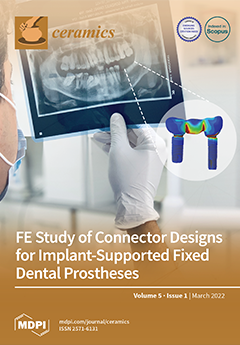In this study, 10 wt.% ceramics—Al
2O
3, La
2O
3, Y
2O
3, MgO, and TiO
2—were employed as additives for amorphous SiO
2 after pressing and annealing at 1300 °C. The amorphous SiO
2
[...] Read more.
In this study, 10 wt.% ceramics—Al
2O
3, La
2O
3, Y
2O
3, MgO, and TiO
2—were employed as additives for amorphous SiO
2 after pressing and annealing at 1300 °C. The amorphous SiO
2 changed to cristobalite SiO
2. Through X-ray diffraction, scanning electron microscopy, and transmission electron microscopy with energy-dispersive spectrometry, the reaction phases of La
2Si
2O
7, Y
2Si
2O
7, and MgSiO
3 (Mg
2SiO
4) were found in the SiO
2 with 10 wt.% La
2O
3, Y
2O
3, and MgO additives. Cracks formed in the Si and SiO
2–ceramic additive sites because of the difference in the coefficients of thermal expansion among the Si, SiO
2, ceramic additives, and reaction phases. After Si came into contact with the SiO
2–ceramics, two types of microstructures were found: those with and those without an amorphous SiO
2 reaction layer at the interface. Amorphous SiO
2 layer formation is due to the replacement of the Si position in SiO
2 by Al
3+ and Ti
4+ impurities, which can break the bonds between Si atoms. The O content in the Si decreased from 6–9 × 10
17 atoms/cm
3 for SiO
2 to less than ~10
16 for SiO
2–Al
2O
3 and SiO
2–MgO. The average resistivity of the Si was 3 Ω·cm for SiO
2 and decreased to 0.12–0.36 Ω·cm for the SiO
2 with ceramic additives.
Full article





